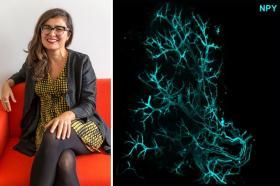Obesity continues to be a major health concern worldwide, and a recent study from Professor Ana Domingos's lab, conducted by DPhil student Yitao Zhu, offers new insights into its biological underpinnings. While many current obesity treatments focus on suppressing appetite, this approach often leads to weight regain due to decreased energy expenditure.
The Domingos Lab’s new study, published in Nature, highlights the role of Neuropeptide Y (NPY), produced by sympathetic neurons, in combating obesity. Unlike its well-known function in the brain to stimulate appetite, the lab's findings suggest that NPY also supports thermogenic adipose tissue—fat that burns energy instead of storing it. This finding aligns with a human genetic association identified by the Common Metabolic Diseases (CMD) Knowledge Portal (KP), which provides a genetic score that indicates how various genes relate to diseases and traits based on extensive human genetic datasets. Notably, the AMP-CMD-KP found a link between NPY and human body mass index (BMI) that does not correlate with changes in food consumption.
From experiments, researchers discovered that a lack of local NPY led to obesity not from overeating, but from reduced energy expenditure. This indicates that for some individuals, enhancing energy dissipation could be more crucial than managing food intake. The study reveals that peripheral NPY encourages the development of fat-burning cells, suggesting that therapies targeting sympathetic neurons might offer a sustainable approach to obesity treatment.
The findings of Professor Domingos’s lab underscore the complexity of obesity and the need to explore new avenues for effective interventions, perhaps including the targeting of specific mechanisms that regulate energy expenditure.
This research was conducted by Yitao Zhu under the guidance of Professor Ana Domingos, with the help from Dr Lu Yao and collaborators around the world including Professor Shingo Kajimura at Harvard Medical School, and Professor Licio Velloso at Unicamp, Sao Paulo.
You can read a more detailed account of their research on the DPAG website.
Read the research paper in Nature via the link below.
